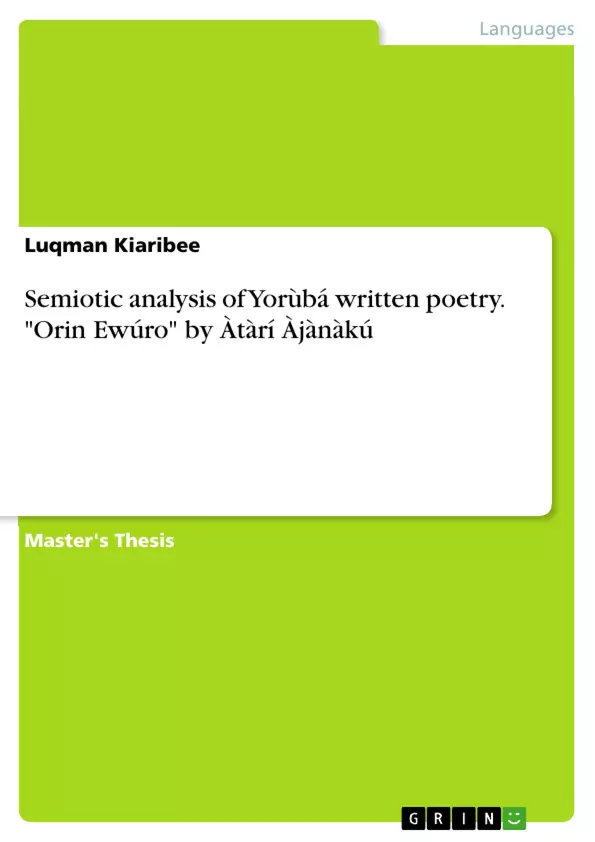Signs, whether consciously or unconsciously used, have a semantics implication on the verbal art. Most especially in poetry, signs are used to pass information across to the reader since poetry economises words than other literary form. The signs use in poetry take different forms which may at time need an eclectic literary approach before the proper understanding of such usage. The proper understanding of the signs used in poetry increases the chance of attributing its proper meaning. This would definitely increase the affective application of literature messages in solving societal problems.
The objective of this study is to find out the use of signs in Àtàrí Àjànàkú’s Orin Ewúro.Doing this will explore some hidden information about the sings used. It will also suggest more probable meanings to these signs.
This reseach is library based. The analysis is presented in a descriptive analytical approach. It is able to describe, explain and analyse signs in Orin Ewúro based on Yorùbá world view. The analysis draws evidences from oral and written Yorúba materials.
The signs in the poems were analysed under eight adopted classifications. These are natural, socio-political, religous, educational, political, economic, literary aesthetic and non-literary aesthetic signs. These were discussed under five chapters. Chapter one is an introduction to the study. The secoǹd chapter is the literature review and the theoretical background. In chapter three and four, signs in Orin Ewúro were analysed using Yorùba semiotic point of view. Chapter five contains the summary, the recommendation and the conclusion of the research work.
At the end of the analysis, the research was able to conclude that the use of signs in poetry is multidimensional. It emphasises that signs could take either of natural, socio-cultural, political, economic, religious, educational, literary and non-literary aesthetics form. It was also able to affirm that there is a need for consideration of contextual factors of poetry before any proper analysis is done on Yorùbá poetry.
Inhaltsverzeichnis (Table of Contents)
- Chapter 1 Introduction
- 1.1 Background to the Study
- 1.2 Statement of the Problem
- 1.3 Objective of the Study
- 1.4 Research Questions
- 1.5 Significance of the Study
- 1.6 Scope of the Study
- 1.7 Research Methodology
- 1.8 Limitation of the Study
- Chapter 2 THE THEORETICAL BACKGROUND AND LITERATURE REVIEW
- 2.1 The Sociological Importance of Poetry
- 2.2 The Place of Semiotics in Literary Criticism
- 2.3 The Review of Existing Literature on Orin Ewúro
- Chapter 3 THE SEMIOTIC ANALYSIS OF ORIN EWÚRO I
- 3.1 Natural Signs
- 3.1.1 Ewúro (Bitter leaf: Vernonia amygdalina)
- 3.1.2 Òṣùpá (The Moon)
- 3.1.3 Èèbù (Yam Seedling)
- 3.1.4 Main Division of the Day and their Correspondence to Human Life Stages (kùtù hàì/ àárò, ìyálèta, òòrùn kàntàrí and ọjó̟ rò̟)
- 3.1.5 Oyé (Harmattan Season)
- 3.2 Socio-Cultural Signs
- 3.2.1 Behavioural Code: Àgbà Lángbá (An Irresponsible Elder)
- 3.2.2 Commodity Code: Agbon (A basket)
- 3.2.3 Behavioural Code: Orogún (A Rival)
- 3.2.4 Commodity Code: Aràbà (A white silk cotton tree)
- 3.2.5 Behavioural Code: ‘Ìjankúkujàn' (A disastrous fall)
- 3.3 Political Signs
- 3.3.1 Àwòrán ìgbà: The Picture of the Time/Period
- Citar trabajo
- Luqman Kiaribee (Autor), 2016, Semiotic analysis of Yorùbá written poetry. "Orin Ewúro" by Àtàrí Àjànàkú, Múnich, GRIN Verlag, https://www.grin.com/document/343644



